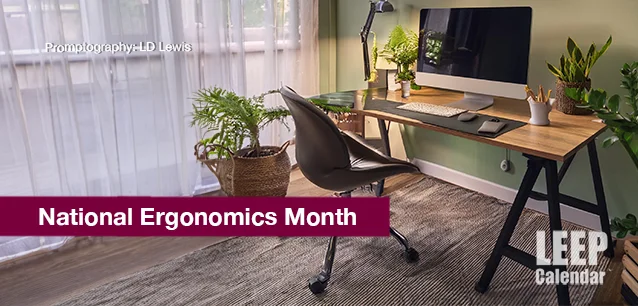 AD
AD
Today is: November 25
Scroll to explore events active on this date.
LEEP INK FEATURES

Nuanced November 2024
November is the start of the holiday season in many parts of the world. It is a time for family, football, food, shopping and decorating, particularly in the Christian and Jewish world, leading to Christmas and...

December's Gift
Events in December 2024. Well, we made it to December. December is the holiday season, particularly in Western nations, where Christianity and Judaism are the faiths most common in the nation's past. ...

August is Appropos
A toddler playing in the fountain at a park in Santa Fe, New Mexico—Photo LD Lewis. In August, we live through the Dog Days of Summer. It's hot and often humid, and those ...
About National Ergonomics Month
Technology & Telecom , Career
Lifestyle , United States
Ends: Oct 31, 2025
DESCRIPTION:
PROMOTING HEALTH AND EFFICIENCY:
ERGONOMICS MONTH
Every October, Ergonomics Month raises awareness about the importance of ergonomics in enhancing human well-being and improving workplace productivity. The event aims to educate the public, employers, and employees about the benefits of applying ergonomic principles in various settings, from offices and factories to schools and homes.
Ergonomics, sometimes called "human factors," is the science of designing and arranging environments, products, and systems to fit the people who use them. Ergonomics aims to optimize human performance while minimizing discomfort and the risk of injury.
Ergonomics is crucial because it directly impacts health, safety, and productivity. Poor ergonomic practices can lead to a range of health issues, including musculoskeletal disorders (MSDs) such as carpal tunnel syndrome, back pain, and repetitive strain injuries. Applying ergonomic principles can significantly reduce these risks, leading to healthier work environments and more efficient, satisfied workers.
INVENTING ERGONOMICS
The ergonomics concept was formally developed during World War II when the need for efficient, safe, and user-friendly equipment became apparent in the military. However, the term "ergonomics" was coined in 1949 by British psychologist Hugh Murrell, who combined the Greek words "ergon" (work) and "nomos" (laws) to describe the study of work. Since its inception, ergonomics has profoundly impacted life worldwide, influencing the design of everything from office furniture and computer systems to vehicles and household products.
Implementing ergonomic principles has significantly improved workplace safety and efficiency across various industries. For example, in manufacturing, ergonomically designed tools and workstations have reduced the incidence of injuries and enhanced productivity. In offices, adjustable chairs, desks, and computer setups have helped employees maintain proper posture, reducing strain and fatigue.
COMMON USES OF ERGONOMICS
Some standard ergonomic products include adjustable office chairs, sit-stand desks, ergonomic keyboards and mice, and monitor stands. These products support the body's natural posture and movements, reducing the risk of strain and injury. Ergonomics also extends to the design of tools, equipment, and even vehicles, where factors such as grip, reach, and visibility remain optimized for user comfort and efficiency.
In addition to physical products, ergonomics plays a crucial role in the design of work processes and environments. For instance, the layout of a workstation or the organization of tasks can be adjusted to minimize repetitive movements and awkward postures, leading to safer and more efficient workflows.
THE FUTURE OF ERGONOMICS
Ergonomics is evolving rapidly, driven by technological advances, changing work environments, and a growing understanding of human health and well-being. Here's how ergonomics is advancing:
—Integration with Technology
Modern ergonomics is increasingly integrating with digital technologies. In real-time, wearable devices and smart sensors monitor posture, movement, and physical stress. These devices can provide immediate feedback to users, helping them correct their posture or adjust their activities to prevent injury. Additionally, virtual reality (VR) and augmented reality (AR) are employed in ergonomic training and design, allowing for immersive simulations that help workers learn proper techniques or experience ergonomically optimized environments before being physically built.
—Remote and Hybrid Work Adaptations
With the rise of remote and hybrid work models, ergonomics adapts to new environments outside the traditional office. Ergonomic principles are applied to home office setups, emphasizing the importance of adjustable furniture, proper lighting, and posture even when working from home. Employers also offer virtual ergonomic assessments to help remote workers optimize their workspaces.
—Personalized Ergonomics
Advancements in data analytics and artificial intelligence (AI) enable a more personalized ergonomics approach. Customized ergonomic solutions can be created by analyzing individual data, such as body measurements, work habits, and specific health needs. For example, AI-driven tools can recommend specific adjustments to workstations or suggest exercises tailored to an individual's unique requirements.
—Inclusive Design
Ergonomics increasingly focuses on inclusive design, ensuring that environments, products, and systems are accessible and comfortable for people of all abilities, ages, and sizes. This shift is driving innovations in ergonomic design that accommodate a broader range of users, from those with disabilities to the elderly, ensuring everyone can work and live comfortably.
—Focus on Mental Ergonomics
While traditional ergonomics has focused on physical comfort and efficiency, there is a growing emphasis on mental ergonomics, which involves designing environments and systems that reduce cognitive load, minimize stress, and enhance mental well-being. For example, user interfaces are redesigned to be more intuitive, reducing the mental effort required. Additionally, workspace designs now consider noise levels, lighting, and air quality, which can impact concentration and stress levels.
—Ergonomics in Emerging Workspaces
As new types of work environments emerge, such as coworking spaces and flexible office layouts, ergonomics is adapting to ensure these spaces meet the needs of a diverse and dynamic workforce. Ergonomists are exploring how to design shared and multipurpose spaces that can be easily adjusted for different users, ensuring ergonomic support across various tasks and activities.
—Sustainability and Ergonomics
There is also a growing intersection between ergonomics and sustainability. Ergonomists are increasingly considering the environmental impact of ergonomic products and designs, including using sustainable materials, designing for durability, and creating products that are both ergonomic and environmentally friendly.
These developments highlight how ergonomics is evolving to meet the needs of a changing world, with a focus on technology, personalization, inclusivity, and overall well-being. As work and life evolve, so will the principles and practices of ergonomics, ensuring that environments remain safe, comfortable, and supportive for all.
VIDEOS
SUPPORTING DOCUMENTS
Currently, this event does not have supporting documents.
ADDITIONAL IMAGES
Currently, this event does not have supporting images.
Where would you like to go now?
 AD
AD


/footer-logo.svg)
